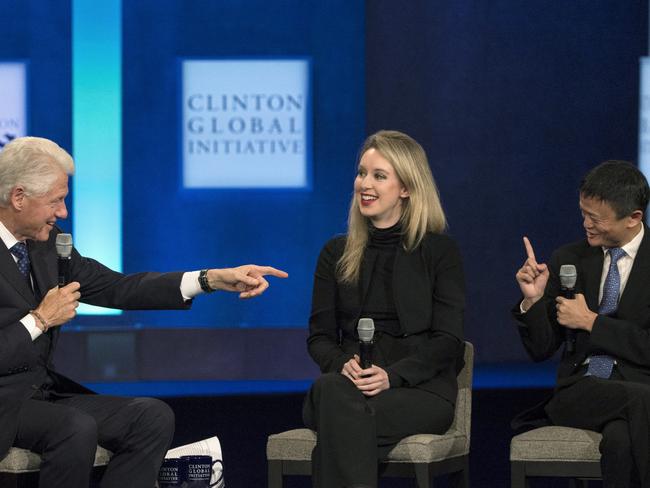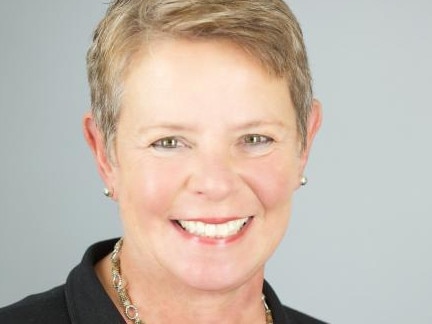Theranos founder Elizabeth Holmes Blood duped ‘rich, white men’
How did a young, blue-eyed dropout build a $9bn empire built on a lie?

One of the great skills of Elizabeth Holmes, the disgraced founder of Theranos, was her ability to accumulate powerful men.
At its height, the medical device developer’s board included two former US secretaries of state, George Schultz and Henry Kissinger; two senators, Sam Nunn and Bill Frist; and a pair of US defence secretaries, Jim “Mad Dog” Mattis, who stepped down from the board in 2017 to take up the government post, and William Perry.
Phyllis Gardner, a Stanford medical professor who helped expose Holmes, has a theory. “Those men’s brains went south in their anatomy,” she says. Holmes, she adds, had a “certain charm” with older, white men.
It may sound outlandish to argue that such powerful figures were hoodwinked by a pretty face and an incredible story: the Stanford dropout who invented a tiny machine capable of running hundreds of medical tests on a finger prick of blood.
But even after the whole edifice crumbled and Holmes was fined, sued, banned and shamed, it is still far from clear exactly how she managed to pull off what prosecutors said was an “elaborate, years-long fraud”.
From the time she founded her company in 2004, the young, blue-eyed, blonde-haired executive raised more than $US700 million ($988m) from some of the sharpest business minds in the world, from Oracle’s Larry Ellison to Robert Kraft, billionaire owner of the New England Patriots football team. She never showed any of them a single audited financial statement.
Gardner, sitting in her living room on the Stanford campus, shakes her head.
“To this day, I can’t explain it, except to say that she’s a sociopathic liar and a narcissist,” she says. “I don’t think she’s brilliant. She’s just a good liar.”
The Theranos scandal has birthed an entire industry: a book (Bad Blood), an HBO documentary (The Inventor), a podcast (The Dropout) and a forthcoming Hollywood dramatisation (also called Bad Blood) starring Jennifer Lawrence.

Silly con
What is most confounding, however, is that Silicon Valley appears to have gleaned so few lessons from the story.
Bill Gurley, one of the world’s most prominent tech investors, tweeted just last week: “Investors poured in over $US700m and no one asked for audited financial statements. This is happening more and more in Silicon Valley. Companies are postponing audits and asking investors to waive audit requirements.”
This is not surprising. In the wake of Theranos, one of the most common refrains among Silicon Valley venture capitalists is how the scandal proved just how smart they are. Because aside from Tim Draper, a well-known investor and a family friend who was one of Holmes’s first backers, not a single venture capitalist put money into the company.
Gardner says: “Venture capitalists do due diligence. And nobody who did due diligence invested.”
The upshot, however, is that an odd complacency laced with self-satisfaction has set in among the tech elite, which virtually assures that the next Theranos is already brewing
A fraud is born
Gardner remembers how it all started. She met Holmes in 2003, when she was a first-year student at Stanford. “She had a bit of acne, brown hair,” she recalls. “And she certainly didn’t have that voice,” she adds, referring to the odd baritone that Holmes took on in later years — along with Steve Jobs-style black turtlenecks. The Apple founder was her idol and she went to great lengths to cast herself in a visionary mould.

Gardner had been introduced to Holmes by John Howard, a former Panasonic executive who later would join Theranos. “He called me and said, ‘I have this brilliant young woman. You have to meet her,’ ” the professor recalls. “I’m not very good when people say ‘brilliant’ — there are two Nobel laureates on my hallway.”
Gardner had advised countless students on their start-ups. She had done a couple herself, worked in venture capital, and spent four years as an executive at a drug delivery company. Despite her misgivings, she agreed to meet Holmes. The bright-eyed student’s idea was a skin patch that could test blood and deliver antibiotics. Gardner took one look at it and told her, “This just isn’t going to work,” she recalled.
Antibiotics, she explained, were not potent enough to be delivered that way, and she knew because she worked at a company that had developed similar transdermal patches. “She didn’t want to listen,” Gardner says.
Months later, Holmes dropped out of Stanford to start Theranos. One of her first investors was Draper, famed for backing Hotmail, Tesla, SpaceX and Skype. His involvement gave her an air of legitimacy.
Holmes shifted from the skin patch to a cartridge-and-reader device, and then to the Edison, the product she promised would “change the world”. It was a sleek, black-and-white box about the size of a microwave that promised to conduct 200 tests from a few drops of blood.
The problem was that it never worked. Holmes, however, acted as if it did. She struck a deal with Walgreens to set up testing centres in some of its pharmacies, even though, according to government investigators, the Edison could perform only 12 of the 200 tests it offered. Others were surreptitiously run on traditional machines made by Theranos’s rivals.
At the time, though, no one was any the wiser, including many inside the company. Holmes created a supremely secretive organisation.
Staff worked under the threat of losing their jobs if they talked about their work with colleagues outside their groups. She was shadowed by an armed security team.
She and company president Sunny Balwani, with whom she had a secret relationship, were known as Eagle 1 and Eagle 2.
The paranoid atmosphere meant that virtually no one inside the company had an overall view of the technology — and the fact it was a mirage.
Externally, Holmes projected extreme confidence. She had a sterling board and her deal with Walgreens was a huge win. The floodgates opened. The Walton family, founders of Walmart, poured in $US150m. Rupert Murdoch, owner of News Corp, publisher of The Australian, invested $US125m, as did the family of US Education Secretary Betsy DeVos. Theranos’s value soared to $US9bn — and Holmes held a majority stake. She was lionised. Four years ago Forbes called her America’s youngest self-made female billionaire.
Scepticism grows
In the background, Gardner was fuming. She had fallen in with a loose group of sceptics from inside and outside the company. They included a pathology blogger, an insider who quit after Theranos rolled out its machines in Walgreens stores despite knowing they generated false results, and Rochelle Gibbons, widow of Theranos chief scientist Ian Gibbons, who committed suicide before he was due to be deposed in a patent lawsuit.
Aside from mutterings that she had heard about the strange company culture, Gardner saw worrying signs that the science itself was deeply flawed: “I was in the background for a long time and I was always gnashing my teeth. It irked me. Students would say, ‘Can we have her come lecture in your class?’ And I’d say, ‘Not on my watch. Not her’ — because I thought she was fabricating data.”
Scandal exposed
In 2015, John Carreyrou, The Wall Street Journal reporter who would go on to expose the scandal, called Gardner. She put him in touch with others in her band of naysayers. When he published his story on October 15, 2015, the Stanford professor provided a quote to bolster his claims.
Theranos, represented by David Boies, a board member, shareholder and one of the fiercest lawyers in America, threatened the paper with litigation. Gardner says: “That’s why I gave a quote. He had to have a quote to publish that article.”
The story was devastating. It claimed that the Edison machines barely worked and that, despite the company’s public efficacy claims, many tests were, in fact, carried out on traditional lab equipment.
The day the story broke, Holmes attended a gala dinner at Harvard, where she was to be appointed to the medical school board of fellows. Also in attendance was Gardner, who had attempted to dissuade Harvard from bringing Holmes into the hallowed institution.
She sat at her table, arms crossed, fuming, as Holmes was crowned: “That night we had dinner at the beautiful house of two of the members, she was sitting there, cosied up to the dean (of Harvard medical school), and I said, ‘Oh, there she goes again, with an older, white man.’
“She had a great story, I’ll give her credit. It sounded good — ‘I’m changing the world’ — but she was endangering patients. You can’t do that.”
Carreyrou went on to publish dozens of stories and the Theranos myth began to unravel. There were harrowing personal accounts, such as patients who wrongly thought they had cancer because of faulty Theranos results. Infectious disease tests gave false negatives, allowing countless people to continue to infect others.
Theranos’s financial statements were pure fiction. Holmes, now 35, told investors the company generated $US108m in 2014 sales. In reality, it brought in a little more than $US100,000.
The Securities and Exchange Commission sued Holmes last year. She was fined $US500,000, banned from being a director of a public company for 10 years and forced to give back millions of shares. Theranos was dissolved last September. The founder did not admit guilt in the SEC settlement but awaits trial on criminal conspiracy and fraud charges. She faces up to 20 years in prison.
The Sunday Times



To join the conversation, please log in. Don't have an account? Register
Join the conversation, you are commenting as Logout